There were many things I wanted to do in Jerusalem, and walking the Via Dolorosa, the Way of Suffering, was high on the list. The circuitous route is believed by many to follow the path that Jesus walked, carrying his cross, on the way to his crucifixion. I’m not necessarily a religious person, but I am a history buff, particularly antiquity and especially Biblical history. I don’t know why, that’s just how I roll and I wanted to see the Stations of the Cross.
The best time to walk the ancient path is early in the morning, before the crowds converge on the Old City. When I walked it I was practically alone, but when I returned later large tour groups made the walk almost impossible to navigate. Plus there is a certain solemnity when alone, right after first light as you walk towards the Church of the Holy Sepulchre. For those looking for a more organized experience, free tours are available Fridays at 3:00 PM led by priests, starting at the Monastery of the Flagellation near the entrance to the Lion’s Gate. This guide though should help anyone navigate the twisty route following the Stations of the Cross.

Station I
With my guide book in hand, I left the hotel and walked the short way to the Old City and the entrance to the Lions’ Gate, the starting point of the Via Dolorosa. Walking through the gate, the first station is a few yards ahead at the present day Umariya Elementary School. Each station is marked with a medallion indicating the station in Roman numerals. You have to pay attention though, because they are easy to miss. As you walk through the souks in the Muslim Quarter, the first station is on your left. It is believed that it was here where Jesus was condemned to death.


Station II
Continue on the Via Dolorosa until you reach the Ecce Homo Convent, location of the second station. It was here where Pontius Pilate gave his famous Ecce Homo, Behold the Man, speech, bound Christ, placed thorns atop his head and gave him his cross. The nearby Ecce Homo archway was part of a larger gateway built by Emperor Hadrian as the entrance to the city Forum. This is one of the easiest stations to find, but keep your eyes open as you continue along the walk.
Station III
As you approach the next intersection, you will turn left, but first look for the third station of the cross located next to the Polish Catholic Chapel. This location marks the first of three times Jesus fell, according to tradition. This is where the Via Dolorosa can get a little confusing, so go slow and keep your eyes peeled for the discs.
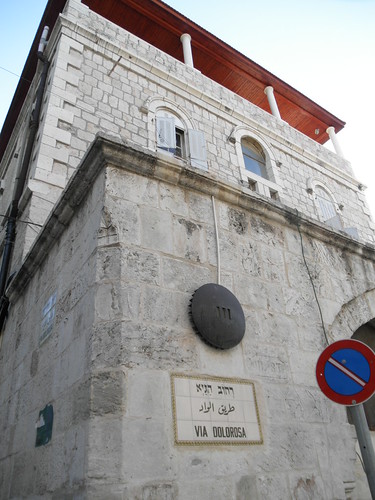
Station IV
After you turn left, the next station will be on your left hand side and is the site where Christ met his mother. Today it is home to an Armenian Orthodox oratory and, according to the sign in the photo I took, a good place to get pizza. Not exactly a solemn feeling, but even a pilgrim has to eat.

Station V
The Via Dolorosa is not a straight road, and this is one of the biggest twists in the path. On the corner of the next street on your right is the fifth station. This is where the Via Dolorosa continues after the curve. The fifth station is where Simon of Cyrene carried the cross for Jesus.

Station VI
The path ascends at this point and among the souks, on the left is the sixth station, which is a little more controversial. According to tradition, this is the point where Veronica wiped the face of Jesus, creating the Veil of Veronica. The Veil supposedly was imprinted with the image of Christ after she wiped his visage.
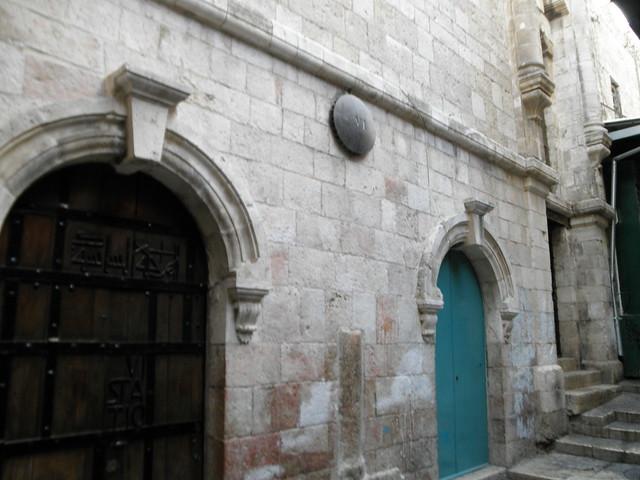
Station VII
Continue walking up through the souks until you once again reach another turn. Before turning left, the colorful red door straight ahead is the location of the seventh station, where Christ fell for the second time. Today the site is next to a Franciscan chapel and the intersection is the site of a major Roman crossroads. Turn left to continue on to the next station.
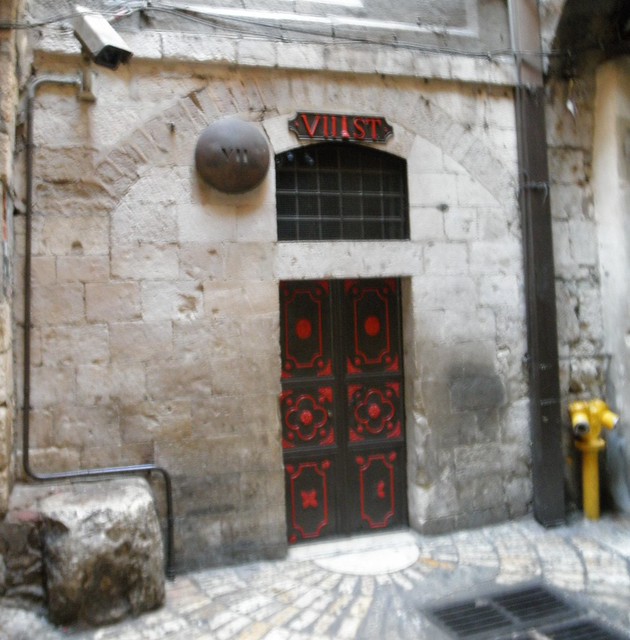
Station VIII
This one is a little tricky to find, but after turning left at Souq Khan al-Zeit, cross the market street and ascend the steps of Aqabat al-Khanqah, opposite the Station VIII Souvenir Bazaar. This often overlooked station is where Jesus met a group of pious women and stopped in order to offer them a sermon. As with so many of the stations, this one is adjacent to a religious institution, the Greek Orthodox Monastery of Saint Charalampus. Return to the Souq Khan al-Zeit to conclude your walk.
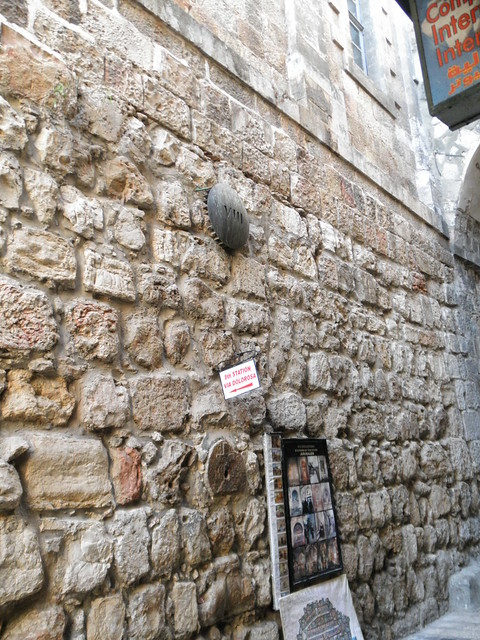
Station IX
Station IX can also be a little confusing to find, but it also marks your departure from the Via Dolorosa and entrance to the Church of the Holy Sepulchre, where the remaining stations of the cross are found. Continue south down Khan al-Zeit and you will soon see an entranceway to the outside on your right. Ascend the stairs and you will find yourself at the Ethiopian and Coptic Monasteries. Every major church is responsible for a certain portion of the Holy Sepulchre, and the Ethiopians control the roof, the present location of their monasteries. Continue along the walkway and you will soon come to an archway topped with a cross and the dome of the Holy Sepulchre in the background. On the pillar just beyond the arch is the ninth station of the cross, where Jesus fell for a third time.
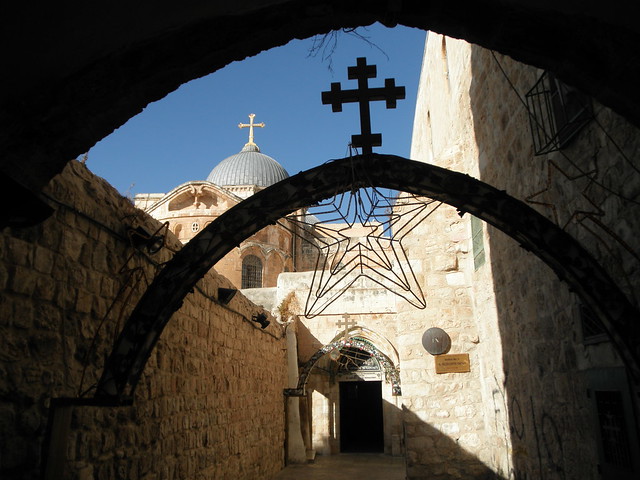
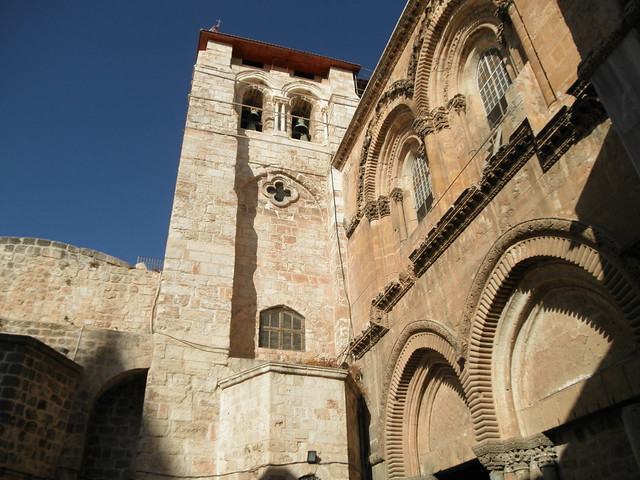
Station X – XIV
Continue along the pathway through the Monasteries, cross a courtyard on your left and go through the door at the end of the yard. This leads down through the Coptic chapel adjacent to the Holy Sepulchre and the courtyard of the Church itself. Enter the massive Church of the Holy Sepulchre through the large, wooden doors and walk up the stairs to Calvary on your right. This entire area of the church marks the next four stations of the cross:
- X Jesus is stripped of His garments (entrance to Calvary)
- XI Crucifixion: Jesus is nailed to the cross (Roman Catholic side altar)
- XII Jesus dies on the cross (main Greek Orthodox altar)
- XIII Jesus’ body is removed from the cross (to the left of the main altar and marked by statue of Mary)
The most impressive of the stations in the Calvary balcony overlooking the church interior is the ornate altar built over the Rock of Calvary, where it is believed the Cross stood. Worshipers may touch or kiss the rock, which pilgrims have believed to be the site of the Holy Cross since the 4th century.
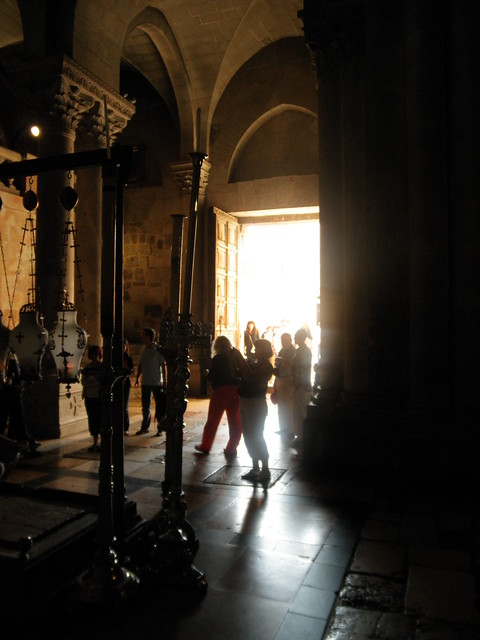
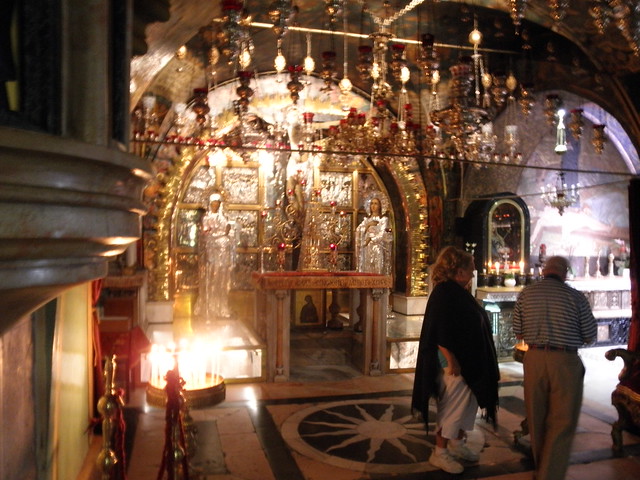
Station XIV
After some moments of reflection, retrace your steps back down the Calvary stairs, pass the Stone of Unction until you reach the rotunda. Under this massive dome is an equally massive black chamber, the aedicule, the tomb of Christ and the site of the final station. Several churches have access to this structure and perform mass at the site daily. The line to enter the strange, cube structure can be quite long, so be sure to visit early. Once you enter, there are two rooms. The first contains a fragment of the stone believed to have sealed Jesus’ tomb and the second is the tomb itself.
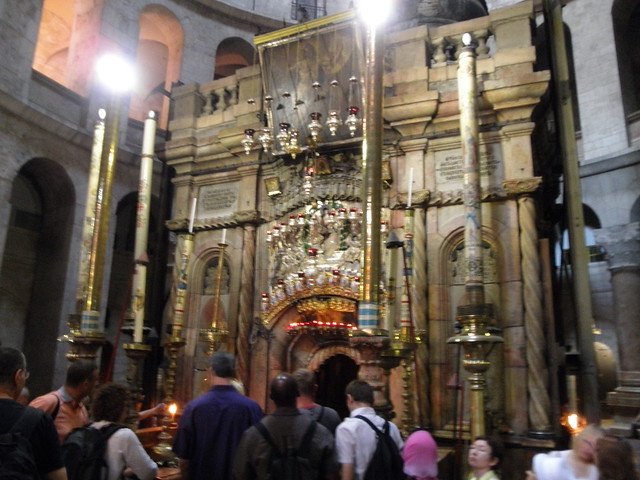

After I completed the Via Dolorosa and visited all fourteen stations of the cross, I wasn’t sure what to do next. I flitted about the Church for a few minutes before deciding that I really couldn’t concentrate, and found a nearby café where I enjoyed fresh pomegranate juice and thought about my morning of historical pilgrimage. Whatever your motivations for visiting Jerusalem and exploring its past, the walk along the pilgrimage path so important to Christians for centuries is a unique way to connect to the storied past of this unusual but endlessly fascinating city.


